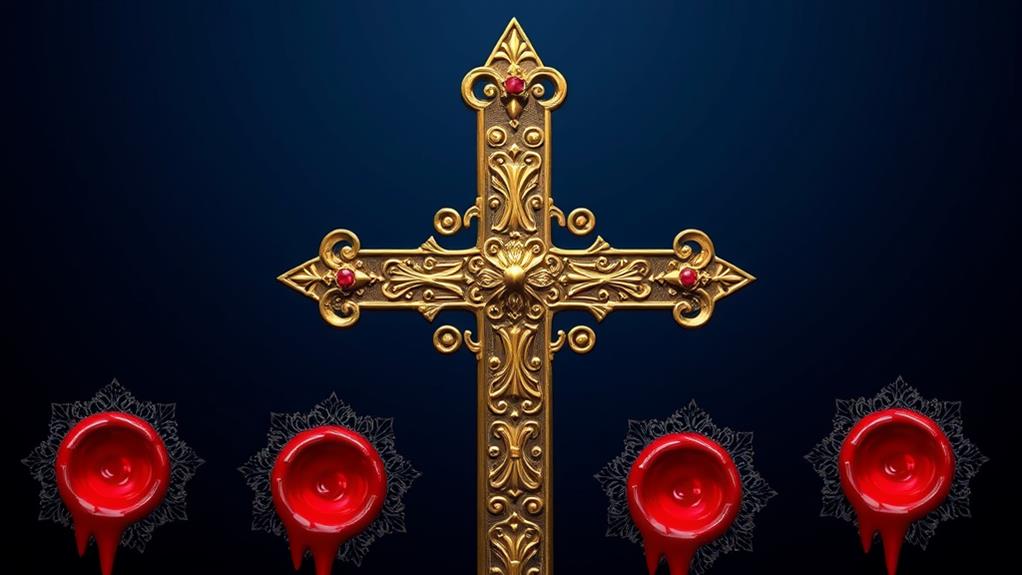As I venture into the world of stigmata tattoos, I'm drawn to the powerful symbolism behind these designs depicting Christ's wounds. Each mark represents a painful reminder of Christ's sacrifice, a badge of honor to the wearer's willingness to bear the burden of their faith. The wounds evoke feelings of vulnerability and surrender, yet also convey hope and redemption, symbolizing the transformative power of faith. From realistic depictions to abstract interpretations, these tattoos tell a story of profound devotion, and as I continue on this journey, I'm enthusiastic to uncover the deeper meaning and significance behind these stunning designs.
The Origins of Stigmata Tattoos
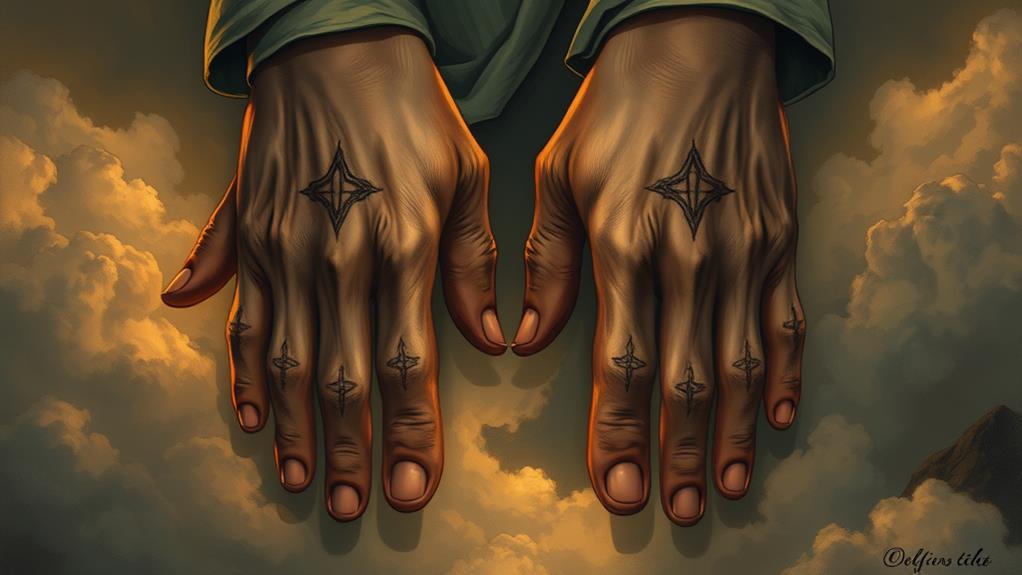
Diving into the domain of stigmata tattoos, I find myself drawn to the rich history that lies beneath the surface.
As I plunge deeper, I'm struck by the profound connection between Christian mysticism and medieval folklore that has shaped this unique art form.
The term "stigmata" itself is derived from the Latin word for "marks" or "wounds," referencing the bodily marks that appeared on the body of Saint Francis of Assisi in the 13th century.
These markings, said to be a physical manifestation of Christ's wounds, were seen as a symbol of spiritual devotion and sacrifice.
In medieval Europe, the veneration of saints and their relics was a widespread phenomenon.
The stigmata, as a physical manifestation of Christ's suffering, became a powerful symbol of devotion and piety.
It's no surprise, then, that stigmata tattoos have their roots in this rich cultural heritage.
As I investigate the world of stigmata tattoos, I'm struck by the reverence and awe that permeate the art form, reflecting the deep spiritual connection between the wearer and the symbol.
Symbolism Behind the Wounds
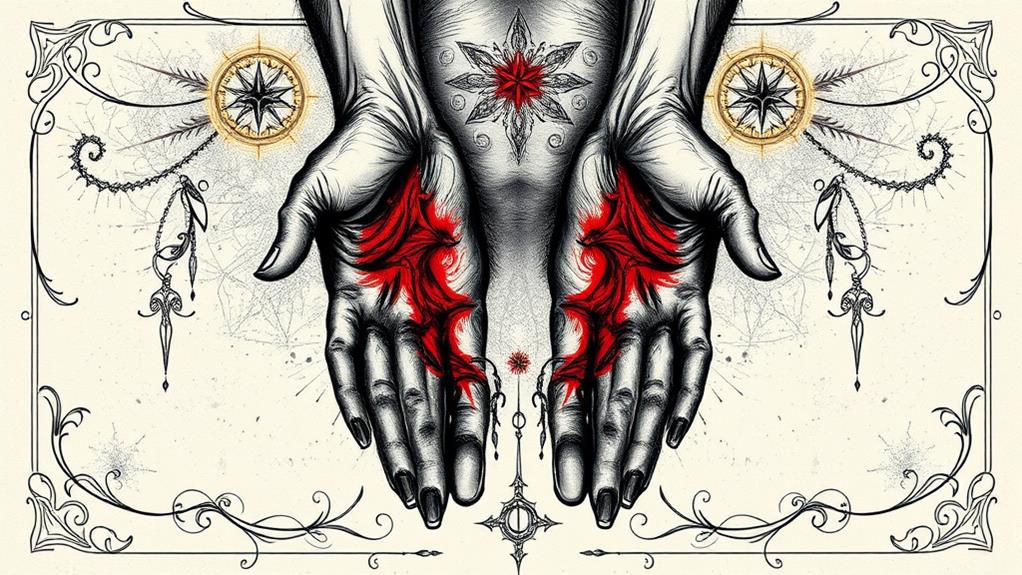
The wounds etched on the skin tell a story of profound devotion, a declaration to the unwavering commitment of the wearer to their faith.
As I excavate into the symbolism behind these wounds, I'm struck by the weight of their significance. Each mark represents a painful reminder of Christ's sacrifice, a badge of honor to the wearer's willingness to bear the burden of their faith.
The wound symbolism is powerful, evoking feelings of vulnerability and surrender.
The painful iconography of stigmata tattoos serves as a poignant reminder of the human experience. It's a visual representation of the struggles we face, the trials we endure, and the scars we bear.
Yet, in their darkness, these wounds also convey a sense of hope and redemption. They symbolize the transformative power of faith, the promise of healing, and the triumph over suffering.
As I reflect on the symbolism behind these wounds, I'm reminded of the profound impact they've on those who wear them – a constant reminder of their devotion, their commitment, and their unwavering faith.
Christ's Wounds in Art History
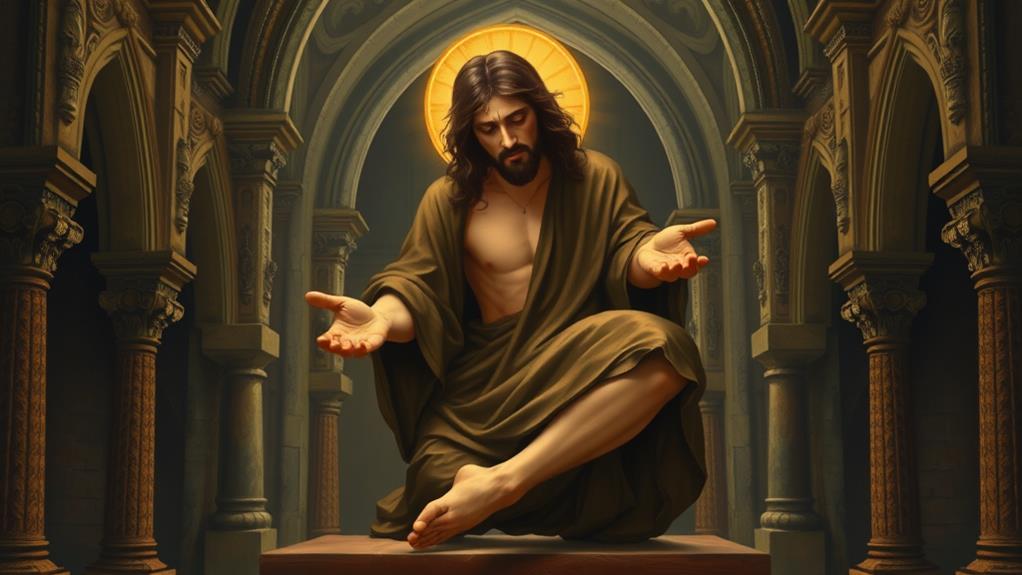
Five centuries of art history have meticulously chronicled Christ's wounds, etching their mark on the canvas of human imagination.
As I plunge into the domain of artistic expression, I'm struck by the profound impact of Christ's wounds on the creative psyche.
From the earliest depictions in Byzantine mosaics to the intricate renderings of Renaissance masters, Christ's wounds have been a recurring theme, inviting artistic interpretation and introspection.
In Early Christianity, the wounds were often symbolic of Christ's sacrifice and redemption, serving as a powerful visual reminder of His ultimate act of love.
Artists, driven by their faith, sought to capture the essence of Christ's suffering, employing vivid colors and emotive brushstrokes to convey the depth of His pain.
As artistic styles evolved, so did the representation of Christ's wounds, with some artists opting for dramatic, almost grotesque, depictions, while others chose more subtle, nuanced approaches.
Throughout, the wounds remained a potent symbol, transcending artistic medium and style to speak directly to the human heart.
Popular Stigmata Tattoo Designs
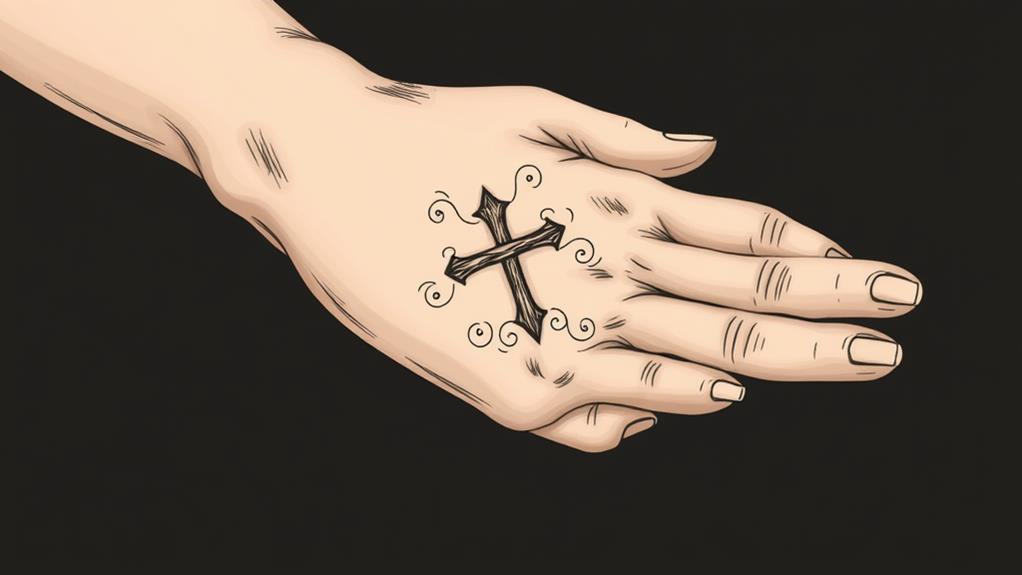
As I venture into the domain of modern body art, I'm fascinated by the way Christ's wounds have inspired a new wave of creative expression – stigmata tattoos.
This sacred symbol has transcended traditional religious art, entering the sphere of tattoo trends and stigmata art. Today, devotees and artists alike are reinterpreting Christ's wounds in innovative ways, resulting in stunning visual representations.
Some popular stigmata tattoo designs include:
- Realistic depictions: Intricate, detailed renderings of Christ's wounds, often with subtle shading and texture, creating a lifelike effect.
- Abstract interpretations: Stylized, symbolic representations of the wounds, blending traditional Christian imagery with modern artistic flair.
- Mixed media designs: Innovative combinations of stigmata art with other visual elements, such as flowers, skulls, or celestial bodies, resulting in unique and thought-provoking pieces.
These designs not only showcase the versatility of stigmata art but also reflect the wearer's personal connection to their faith and spirituality.
As tattoo trends continue to evolve, it's clear that stigmata tattoos will remain a powerful and enduring symbol of devotion.
The Crown of Thorns Tattoo
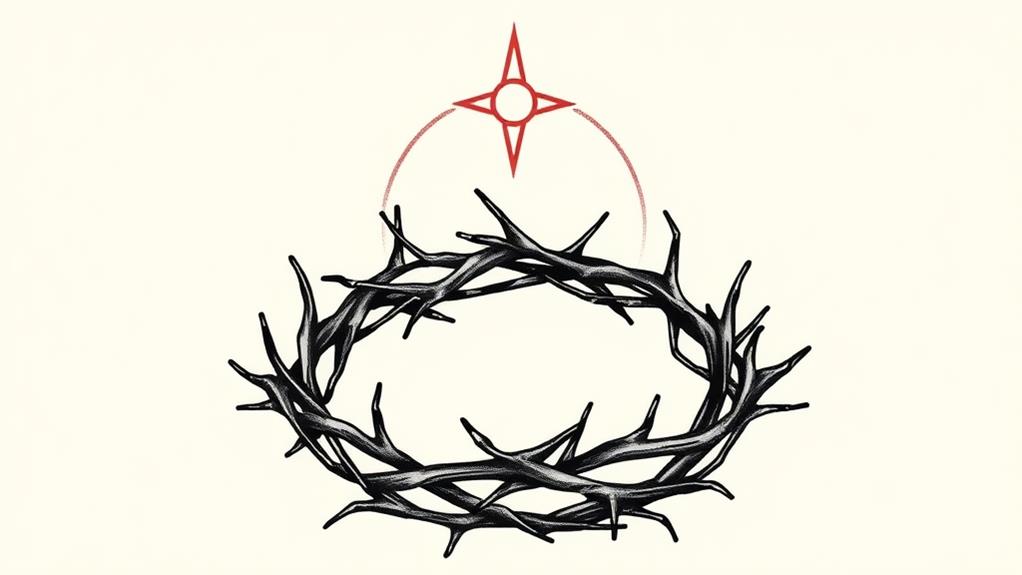
Worn like a badge of honor, the Crown of Thorns tattoo is a potent symbol of sacrifice, humility, and unwavering devotion.
As I explore into the significance of this design, I'm struck by the depth of its meaning. The Crown of Thorns represents the ultimate sacrifice made by Christ, and its presence on my skin serves as a constant reminder of His love and sacrifice.
Thorn symbolism is particularly striking in this design, as it evokes feelings of pain, struggle, and perseverance.
The thorns that pierce Christ's brow symbolize the weight of our sins, and the blood that flows from them represents the redemption we've been granted. The Crown itself holds significance as a symbol of royalty, emphasizing Christ's divine nature and His role as the King of Kings.
For me, the Crown of Thorns tattoo is a powerful expression of my faith and a declaration to the transformative power of Christ's sacrifice.
It's a design that commands respect, inspires contemplation, and serves as a lighthouse of hope in a world torn apart by darkness and despair.
Nailing the Details: Crucifixion Tattoos
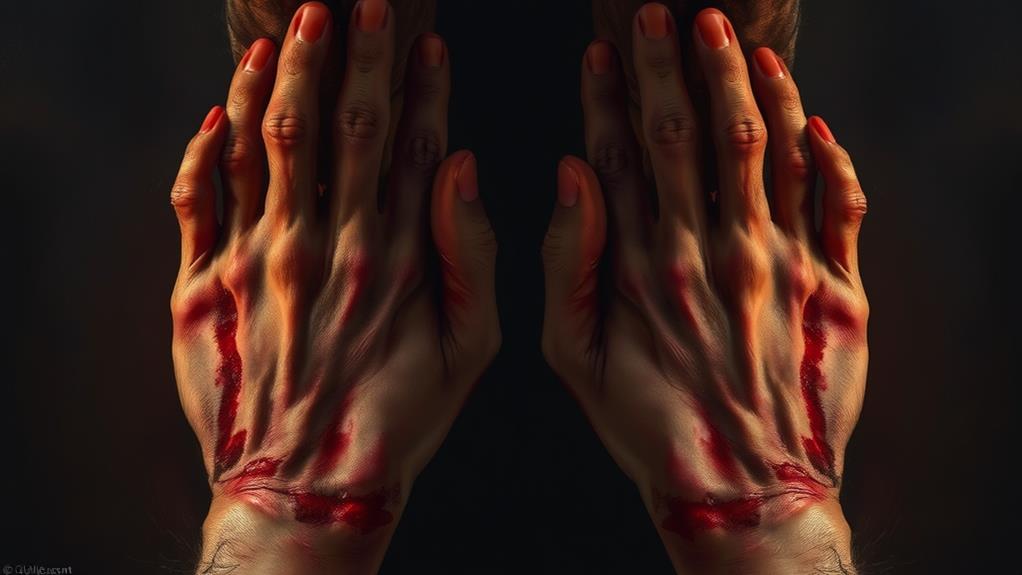
While the Crown of Thorns tattoo serves as a poignant reminder of Christ's sacrifice, the Crucifixion tattoo takes this symbolism to its most visceral and powerful extreme.
This design choice isn't for the faint of heart, as it graphically depicts the moment of Christ's ultimate sacrifice. I find myself drawn to the raw emotion and intensity that this tattoo embodies.
As I plunge deeper into the world of Crucifixion tattoos, I'm struck by the attention to detail that sets each piece apart.
Cross variations: From the traditional Latin cross to more ornate, Celtic-inspired designs, the cross itself becomes a canvas for artistic expression.
Anatomical accuracy: The subtle nuances of Christ's pose, the tension in his muscles, and the flow of blood from his wounds all contribute to a sense of realism that's both haunting and beautiful.
Shading and texture: The strategic use of shading and texture can evoke a sense of depth, adding a layer of emotional complexity to the overall design.
Through these careful considerations, the Crucifixion tattoo becomes a powerful tribute to Christ's sacrifice, one that invites contemplation and reverence.
The Spear of Destiny Tattoo
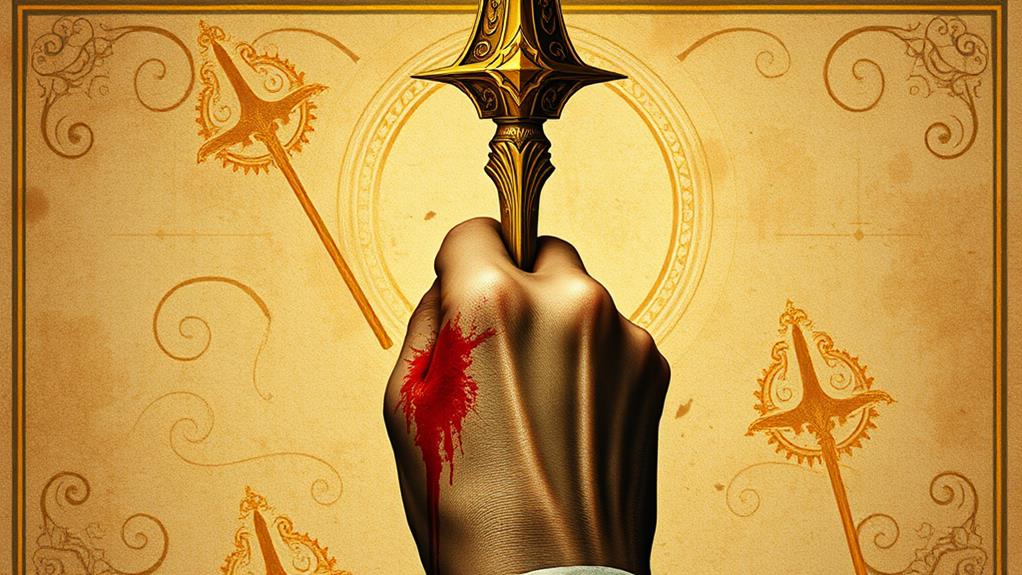
Delving into the domain of Christian iconography, I find myself enthralled by the Spear of Destiny tattoo, an intricate design that weaves together history, mythology, and spirituality.
This tattoo takes its inspiration from the Spear legend, which tells the story of the spear used by Longinus to pierce Christ's side during the Crucifixion. According to legend, the spear was imbued with mystical powers, making it a symbol of spiritual awakening and empowerment.
The Spear of Destiny tattoo often features the spearhead surrounded by ornate details, such as vines, flowers, or clouds, which add a sense of depth and symbolism to the design.
The Destiny meaning behind this tattoo is profound, as it represents the connection between the physical and spiritual spheres. For those who wear this design, it serves as a reminder of Christ's sacrifice and the transformative power of faith.
As a tattoo, the Spear of Destiny is a powerful statement of devotion, spirituality, and personal growth.
Blood and Tears: Emotional Significance

As I reflect on my stigmata tattoo, I'm drawn to the blood and tears that flow from Christ's wounds, symbolizing a painful spiritual connection that transcends human understanding.
In this sorrowful divine union, I sense a profound intimacy with the divine, as if Christ's suffering has become my own.
Through this tattoo, I'm reminded that true devotion requires embracing the agony and the ecstasy.
Painful Spiritual Connection
I've always been drawn to the mystical and the unknown, and stigmata tattoos evoke a deep sense of reverence within me.
There's something about the visual representation of Christ's wounds that speaks to me on a profound level. For me, these tattoos represent a painful spiritual connection – a tangible expression of faith that transcends the physical domain.
As I dig deeper into the significance of stigmata tattoos, I'm struck by the following aspects:
- Faith scars: These tattoos serve as a permanent reminder of the sacrifices made by Christ, and the wearer's devotion to their faith.
- Spiritual branding: By embracing the stigmata design, individuals are, fundamentally, branding themselves as followers of Christ, unafraid to display their conviction.
- Vulnerability: Stigmata tattoos often depict open wounds, symbolizing the vulnerability and humility that come with surrendering to a higher power.
Through these tattoos, individuals can externalize their internal struggles, creating a sense of community and solidarity with others who share their beliefs.
For those who wear them, stigmata tattoos become a powerful evidence to their unwavering faith.
Sorrowful Divine Union
Five crimson rivers flow from Christ's hands, feet, and chest, converging into a profound symbol of sorrowful divine union.
As I gaze upon this stigmata design, I'm struck by the depth of divine suffering it represents.
The blood flowing from Christ's wounds is more than just a physical manifestation of pain – it's a declaration to the sacred empathy He shares with humanity.
In this sorrowful divine union, I see a reflection of my own struggles and the struggles of those around me.
The tears I've cried, the pain I've endured, and the darkness I've faced are all mirrored in Christ's wounds.
And yet, in this shared experience of suffering, I find comfort.
I'm reminded that I'm not alone, that my Savior has walked the same path and emerged victorious.
This stigmata design is a poignant reminder of the sacred bond between Christ and humanity.
It's a symbol of the love that drives Him to suffer alongside us, to weep with us, and to ultimately redeem us.
As I wear this design on my skin, I'm reminded to enfold my own sorrows, to seek comfort in Christ's wounds, and to find consolation in our sorrowful divine union.
Stigmata Tattoo Placement Options
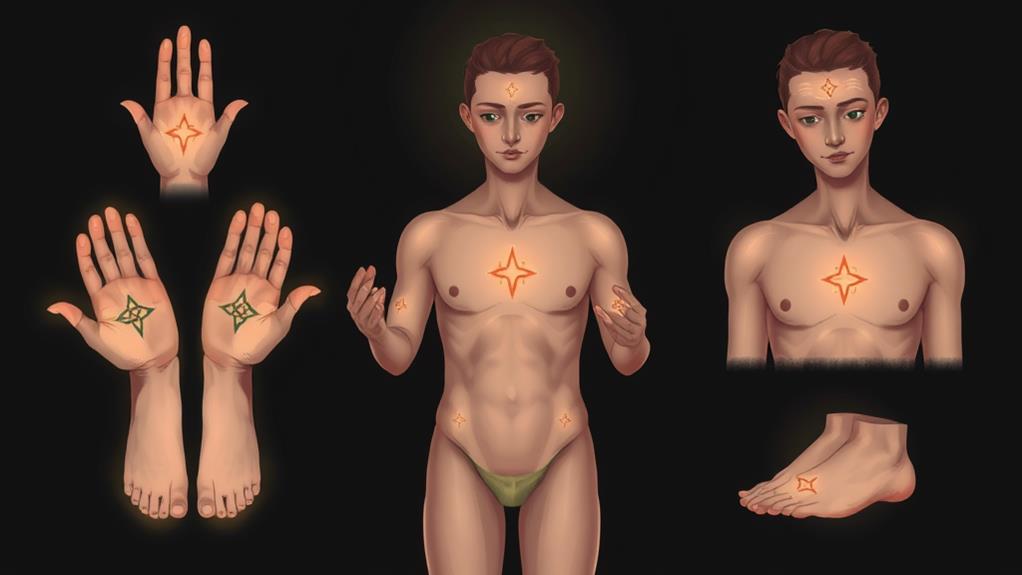
Discovering the perfect placement for my stigmata tattoo is a crucial step in this sacred journey, as the location will amplify the symbolic meaning and personal significance of this profound design.
I want to strategically position my stigmata tattoo to serve as a constant reminder of Christ's sacrifice and my devotion to Him.
When considering placement options, I'm drawn to areas that allow for subtle yet meaningful displays of my faith.
- Wrist placement: A delicate stigmata design on my wrist serves as a gentle reminder of Christ's wounds, while also allowing me to easily conceal the tattoo if needed.
- Ankle accents: A small, intricate stigmata design on my ankle adds a touch of elegance and subtlety, making it an ideal placement for those who prefer understated expressions of faith.
- Upper back or shoulder: Placing my stigmata tattoo on my upper back or shoulder creates a sense of protection and shielding, symbolizing Christ's sacrifice as my spiritual armor.
Small yet Powerful Designs
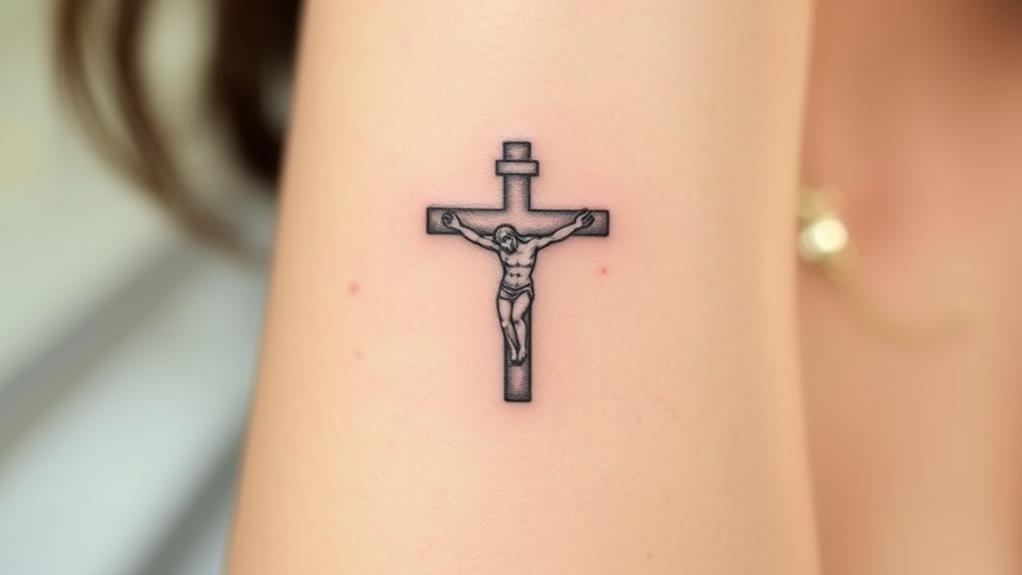
Embracing the subtlety of stigmata tattoos, I find comfort in designs that exude profound meaning in small, yet powerful packages.
These tiny tattoos speak volumes about one's faith and personal convictions, making them a compelling choice for those who prefer understated yet poignant expressions of devotion.
I'm drawn to the small significance of these designs, which often belie their profound impact.
A delicate, intricately designed stigmata on the wrist or behind the ear can be a constant, gentle reminder of one's spirituality.
These tattoos become an intimate, personal expression of faith, subtly declaring one's allegiance to a higher power.
The beauty of small stigmata tattoos lies in their ability to convey a powerful message without being overt or flashy.
They're a badge of honor to the idea that faith can be both deeply personal and quietly confident.
As I venture into the world of stigmata tattoos, I'm struck by the ways in which these small, powerful designs can inspire and uplift, serving as a lighthouse of hope and devotion.
Color Vs. Black and Grey
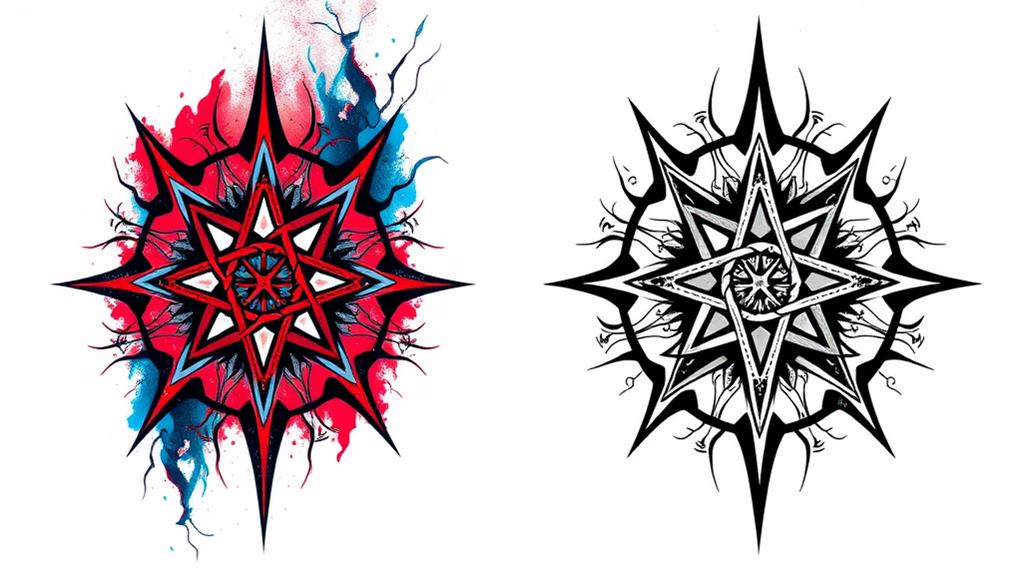
As I venture into the domain of stigmata tattoos, I find myself pondering the role of color in these powerful designs.
The use of color can greatly intensify the emotional impact of a stigmata tattoo, but it's not the only option. In fact, many artists and collectors prefer black and grey ink for these designs.
Three key considerations when deciding between color and black and grey:
1. Color contrast: Colorful stigmata tattoos can create a striking contrast between the wounds and the surrounding skin, drawing attention to the symbolism.
However, this contrast can also make the design more overwhelming.
2. Ink preferences: Some artists specialize in vibrant, bold colors, while others prefer the subtlety of black and grey.
It's essential to choose an artist who shares your vision and can execute it effectively.
3. Tone and atmosphere: Black and grey stigmata tattoos can create a more somber, contemplative atmosphere, while colorful designs can evoke a sense of hope and redemption.
Ultimately, the choice between color and black and grey comes down to personal preference and the message you want to convey through your tattoo.
Stigmata Tattoo Aftercare Tips

Getting a stigmata tattoo is a significant milestone, but it's only the beginning of my journey.
Now that I've taken the leap, I want to guarantee my new tattoo heals properly to avoid any tattoo regrets.
A vital part of this process is establishing a thorough aftercare routine.
I've learned that the first few days are critical.
I'll keep my tattoo clean and moist, washing it gently with soap and lukewarm water three to four times a day.
I'll also apply a thin layer of fragrance-free lotion to keep it hydrated.
It's essential to avoid direct sunlight, tight clothing, and soaking in water for the first two weeks.
As my tattoo heals, I'll monitor its progress closely, watching for signs of infection like redness, swelling, or discharge.
If I notice any unusual symptoms, I won't hesitate to reach out to my tattoo artist or a medical professional for guidance.
Celebrities With Stigmata Tattoos
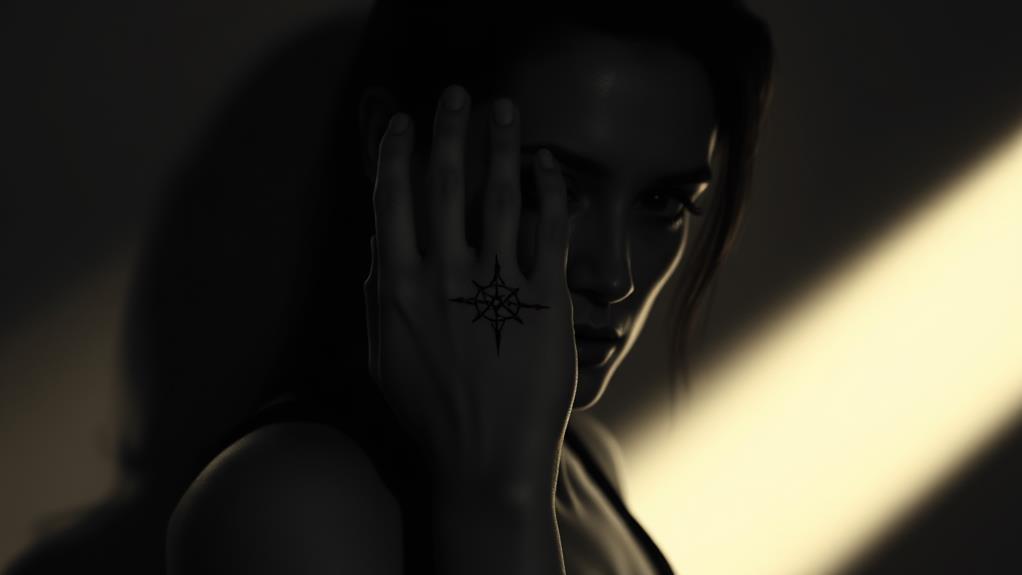
My fascination with stigmata tattoos extends beyond my personal experience, and I've always been curious about others who share my devotion.
As I plunge further into the world of stigmata tattoos, I'm intrigued by the number of celebrities who've adopted this unique design.
Their boldness in showcasing their faith-inspired tattoos has unquestionably contributed to the growing acceptance of stigmata tattoos in mainstream culture.
Several celebrities have helped break down tattoo taboos by proudly displaying their stigmata tattoos.
- Justin Bieber: The pop sensation has a stigmata tattoo on his ankle, which he got in 2013. His bold move sparked a wave of interest in stigmata tattoos among his massive fan base.
- Colton Underwood: The former NFL player and reality TV star has a stigmata tattoo on his forearm, which he got as a symbol of his Christian faith.
- Demi Lovato: The singer and actress has a stigmata tattoo on her hand, which she got in 2013. Her bold move helped normalize stigmata tattoos in the entertainment industry.
These celebrities' influence has unquestionably played a significant role in popularizing stigmata tattoos, making them more mainstream and socially acceptable.
Stigmata Tattoos in Modern Culture
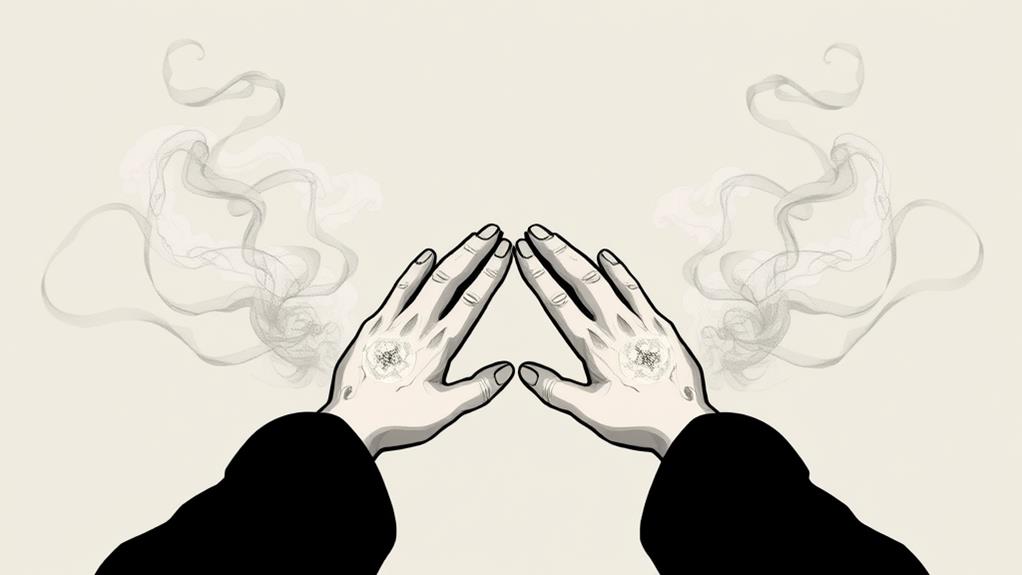
Embracing the sacred and the profane, stigmata tattoos have transcended their religious roots to become a mainstream phenomenon, with their presence felt in various aspects of modern culture.
I've noticed that stigmata tattoos have become a symbol of rebellion, spirituality, and self-expression, appealing to individuals from diverse backgrounds.
In the domain of art, stigmata tattoos inspire modern expressions of faith, hope, and resilience.
They've also become a cultural symbol, transcending religious boundaries to represent a deeper human connection.
In contemporary society, stigmata tattoos have gained cultural relevance, symbolizing the struggle for identity, individuality, and freedom.
They've become a visual representation of the human experience, conveying emotions, thoughts, and beliefs.
I believe that stigmata tattoos have evolved into a powerful form of self-expression, allowing individuals to showcase their unique perspectives and values.
As a cultural phenomenon, stigmata tattoos continue to inspire and intrigue, offering a glimpse into the complexities of human nature.
The Spiritual Significance of Stigmata
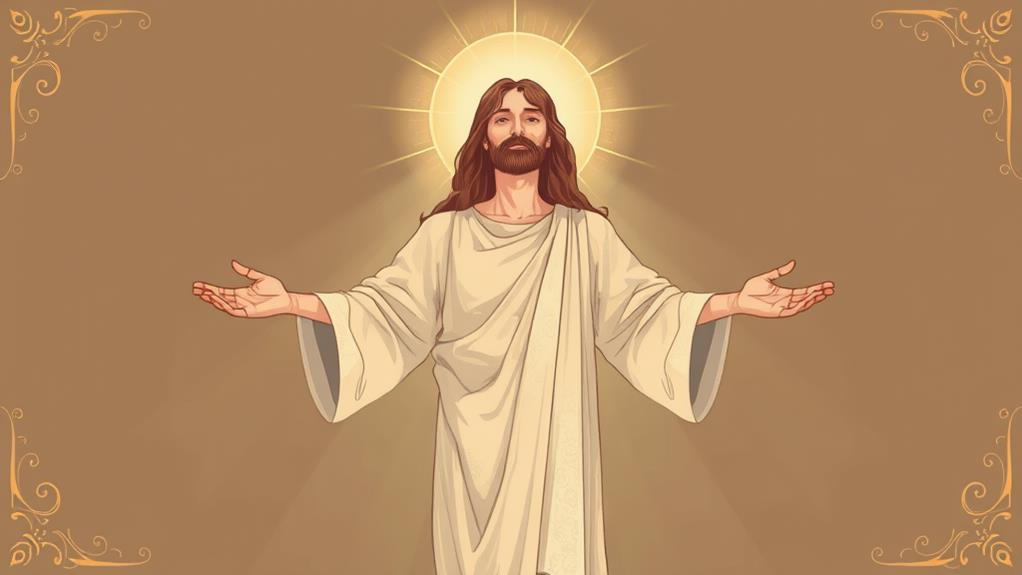
As I plunge into the domain of stigmata, I find myself drawn to the mystical aura surrounding this sacred phenomenon,
where the divine and human converge in a dance of transcendence.
The spiritual significance of stigmata lies in its profound symbolism, which transcends the physical domain and speaks directly to the soul.
For me, stigmata embodies the essence of spiritual stigma, a manifestation of the divine markings that set apart the chosen ones.
These markings aren't mere physical wounds but a declaration to the profound connection between the human and the divine.
- Divine Communion: Stigmata represents a deep, intimate connection with the divine, where the boundaries between the human and the sacred are blurred.
- Redemptive Suffering: The wounds of stigmata symbolize the redemptive power of suffering, reminding us that our struggles can be transformed into a means of spiritual growth.
- Transcendent Identity: By bearing the divine markings, stigmata tattoos become a symbol of a transcendent identity, one that's rooted in the sacred and goes beyond the confines of the human experience.
Frequently Asked Questions
Can I Get a Stigmata Tattoo if I'm Not Catholic?
As I ponder getting a tattoo symbolizing Christ's wounds, I question if I need to be Catholic to do so; honestly, it's about my spiritual identity and personal conviction, not denominational affiliation, that drives my desire for this meaningful body art.
Are Stigmata Tattoos Considered Disrespectful to Christianity?
As I consider getting a tattoo, I wonder if it's disrespectful to Christianity. Honestly, I think it's a Christian taboo, and some might view it as religious appropriation, but I believe it's about personal reverence, not disrespect.
Can I Customize My Stigmata Tattoo With Personal Symbols?
I can definitely customize my tattoo with personal symbols, blending them with traditional stigmata designs to create a unique, symbolic fusion that resonates with my faith and personalized meanings, making it a deeply reverent expression of my spirituality.
Will My Stigmata Tattoo Be Considered "Fake" if I'm Not Religious?
Honestly, I don't think my spiritual identity is defined by religious affiliation; it's about personal authenticity. If I choose a stigmata tattoo, it's because it resonates with me, not because I'm trying to fit into a specific faith.
Can I Get a Stigmata Tattoo if I Have a Dark Past or Troubled History?
I believe my dark past can be a catalyst for a redemption narrative, and getting a stigmata tattoo can symbolize my personal atonement, serving as a powerful reminder of my journey towards healing and forgiveness.
